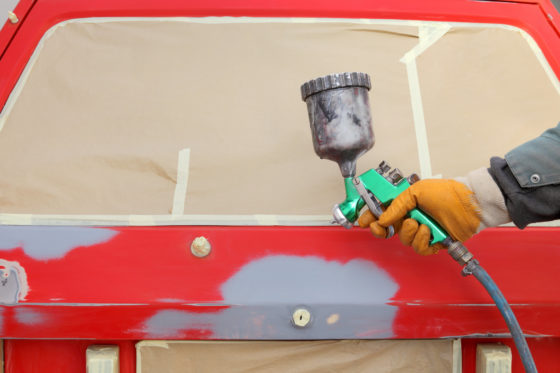WorkSafeBC inspectors see too many manufacturing shop workers spraying paint in makeshift booths or other areas not designed to control the hazards.

Photo credit: iStock.com/simazoran
Reading this new bulletin from WorkSafeBC, Reducing the risk of fires or explosions when spraying flammable products, made me think about a friend of mine who uses a lot of flammable substances at work. He and his coworkers make custom props for the film and TV industry, and they spray aerosol, paints, sealants, glues, lubricants, acetone, and isopropyl alchohol – just to name a few.
A spray can ignite if it is used without proper ventilation near open flame, electrical equipment, and other ignition sources. WorkSafeBC issued the bulletin after safety officers saw a number of manufacturers who needed to up their safety game while spraying paints and other airborne products. Barry Nakahara, WorkSafeBC’s prevention manager for the Prince George and Terrace regions, said his colleagues saw it most often in small to medium metal shops, where painting was not the bulk of their work.
“They may paint only once a week – often on the weekends or after hours and they’re doing it in the shop areas where ignition sources are not properly controlled,” Barry says.
“What we’re seeing is that it tends to happen in bay areas or makeshift spray booths. They’re not completely designed for that type of application. Many of the spray paints contain flammable liquids that create flammable vapours and aerosols. These can be explosive when you have the right mixture with air in an environment.”
Avoiding the risk of ignition, fire, explosion
Barry describes what some employers have done in response to being made aware of this hazard: “Some have put in temporary interim measures, such as moving their painting operations outdoors, but now that winter’s hitting, they’re having to consider moving indoors.”
To find out more about how electrical equipment can coexist safely where hazardous concentrations of gas, vapours, or dust may be encountered, see this bulletin from Technical Safety BC (formerly known as the BC Safety Authority): Guidelines for Determining Hazardous Area Classifications. If you have questions about a particular workplace situation, please contact WorkSafeBC’s Prevention Information Line.
Going back to my friend’s situation, I asked him how they deal with those flammable substances at his workplace. He told me that the chemicals are all stored in closed, fire-proof cabinets, and only ever used in a ventilated workspace, under a hood, with fans on. Workers must wear their PPE, including respirators, goggles, and nitrile gloves, when handling or applying any of these airborne chemicals.
He said they use small quantities of these substances regularly – depending on what’s needed for specific projects. I’d like to tell you more about what they make, but it’s top secret stuff!


